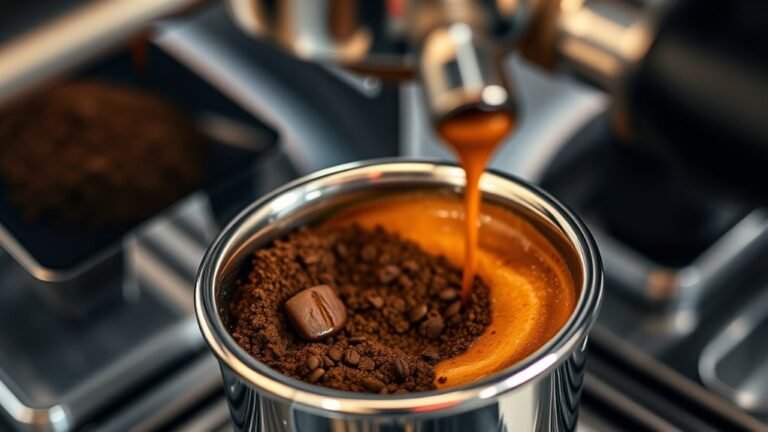The Moka Pot: Your Guide to Stovetop Espresso
You’ll want to understand your moka pot’s three parts: the water chamber, filter funnel, and collection chamber, each designed for precise pressure and extraction. Use a medium-fine grind—finer than drip but coarser than espresso—and fill the basket evenly without tamping. Heat steadily, remove the pot at the hissing sound to avoid over-extraction, and keep your pot clean without soap to preserve flavor oils. Master these fundamentals, and your stovetop espresso technique will elevate considerably.
Understanding the Moka Pot Components

A Moka pot consists of three main components: the bottom chamber, the filter funnel, and the upper chamber. The bottom chamber holds water, pressurized by heat to force steam through the coffee grounds in the filter funnel. This funnel’s size and shape vary among moka pot types, directly influencing the brewing capacity—commonly ranging from 1 to 12 cups. The upper chamber collects the brewed coffee, designed to guarantee ideal extraction and pressure release. Understanding these parts helps you choose a moka pot that matches your desired brewing capacity and personal freedom to craft espresso-style coffee without reliance on electricity or pods. Each component’s precision engineering allows you to control extraction variables, empowering you to tailor your coffee experience with reliability and consistency every time.
Selecting the Perfect Coffee Grind
Once you’ve familiarized yourself with the moka pot’s components, the next step is to focus on the coffee grind size, which directly impacts extraction efficiency and flavor profile. For peak results, use a medium-fine grind—finer than drip coffee but coarser than espresso. This balance guarantees water pressure flows correctly through the coffee bed, preventing over-extraction or clogging. Adjusting grind size is essential to mastering your brewing techniques; too coarse, and your brew will be weak and under-extracted; too fine, and it risks bitterness or a slow brew. Experiment with grind size to match your moka pot’s specifics and personal taste, allowing freedom to tailor flavor intensity and body. Precision here releases the moka pot’s full potential for stovetop espresso.
Step-by-Step Brewing Process
Three primary steps form the foundation of the moka pot brewing process: filling the water chamber, adding the coffee grounds, and assembling the pot. Start by pouring water just below the safety valve—precision here guarantees ideal pressure buildup. Next, measure your coffee grounds using the perfect coffee ratios: fill the filter basket evenly without tamping, preserving proper extraction. After placing the filter basket into the water chamber, screw the upper chamber tightly to prevent leaks.
Place the moka pot on medium heat, monitoring closely as brewing techniques dictate a gradual rise in pressure forces water through the coffee grounds. As you hear a hissing sound, remove the pot promptly to avoid over-extraction. Mastering these steps lets you control strength and consistency, granting you freedom in your stovetop espresso journey.
Tips for Enhancing Flavor and Aroma

Perfecting the brewing steps sets a solid foundation, but dialing in the flavor and aroma requires attention to finer details. To enhance flavor profiles, start by selecting freshly roasted, quality beans and grinding them to a medium-fine consistency tailored for moka pots. Control the heat source carefully; moderate, steady heat guarantees ideal extraction without bitterness. Preheating water minimizes brewing time, preserving delicate aromatic compounds. Experiment with the grind size and water temperature to balance acidity and body, tuning the brewing techniques to your taste. Avoid tamping the coffee, as compacting restricts flow and alters flavor extraction negatively. Finally, allow the brewed coffee to settle briefly before pouring to let volatile aromatics develop fully, revealing the moka pot’s potential for a rich, nuanced cup that matches your freedom to customize.
Cleaning and Maintenance Practices
Although brewing quality coffee is vital, maintaining your moka pot through regular cleaning and careful upkeep is equally important to guarantee consistent performance and longevity. You should disassemble your pot after every use, rinsing components with warm water only—avoid soap to preserve natural oils essential for flavor. Employ cleaning techniques such as using a soft brush to clear the filter and gasket, preventing buildup that impairs extraction. For deep cleaning, periodically soak parts in a vinegar-water solution to dissolve mineral deposits. Monitor maintenance frequency based on water hardness and usage intensity; a biweekly deep clean is recommended for daily users. Regularly inspect and replace the rubber gasket and safety valve to maintain pressure integrity. This disciplined approach guarantees your moka pot operates freely, delivering rich espresso without compromise.
Frequently Asked Questions
Can I Use a Moka Pot on an Induction Stove?
Using a moka pot on an induction stove is like trying to play a vinyl record on a digital player—it often won’t work because traditional aluminum moka pots lack induction compatibility. Induction stoves require magnetic materials, so unless your moka pot has a stainless steel base designed for induction, it won’t heat properly. For freedom in brewing, consider moka pot alternatives made from induction-friendly materials or use an induction adapter plate to bridge the gap.
What’S the Best Water Temperature for Brewing?
When brewing with a moka pot, aim for water just off the boil—around 90-95°C (194-203°F)—to optimize extraction without burning the coffee. Using high-quality water is essential; impurities can alter taste and affect pressure buildup. Mastering this temperature range enhances your brewing techniques, giving you control over flavor intensity and aroma. This freedom lets you tailor each cup precisely, ensuring a balanced, rich espresso every time.
How Long Does Coffee Stay Fresh in a Moka Pot?
Did you know brewed coffee starts losing its peak flavor within 30 minutes? When it comes to coffee freshness in your moka pot, it’s best to consume it immediately. If you must store it, pour the coffee out of the moka pot into an airtight container and refrigerate—it’ll stay fresh for up to 24 hours. Leaving coffee in the moka pot leads to bitterness and staleness, so moka pot storage isn’t ideal long-term.
Are There Any Safety Tips for First-Time Users?
When you’re new to the moka pot, safety precautions are essential during the brewing process. Always verify the gasket and filter are properly placed to prevent leaks or pressure buildup. Don’t overfill the water chamber—stick to the safety valve level. Use medium heat to avoid overheating, and never force the lid open while brewing. These steps keep your experience safe and let you enjoy espresso freedom without worries.
Can I Brew Tea or Other Beverages in a Moka Pot?
Certainly, you can creatively craft caffeine concoctions beyond coffee! While moka pots are meticulously made for espresso extraction, tea brewing or beverage alternatives like herbal infusions can be attempted, though not ideally. The steam pressure and metal filter may alter delicate tea flavors, so you’ll want to experiment cautiously. For freedom to explore flavors, consider adjusting grind size, water temperature, and steep time to tailor your taste while safeguarding your moka pot’s function.






